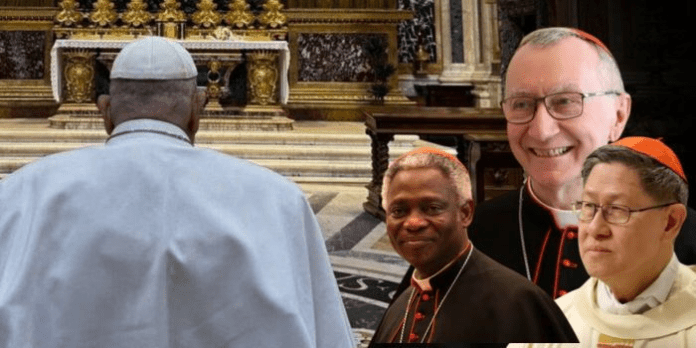
As the Catholic Church mourns the passing of Pope Francis, attention now turns to the Vatican, where preparations for the selection of his successor are underway.
Pope Francis passed away on Easter Monday, April 21, 2025, after battling double pneumonia for over a month.
“Pope Francis died on Easter Monday, April 21, 2025, at the age of 88 at his residence in the Vatican’s Casa Santa Marta,” Vatican News confirmed in a statement shared on X (formerly Twitter).
Following the death of a Pope, the Church enters a period known as Sede Vacante—a Latin term meaning “vacant seat”—during which the papal office remains officially unoccupied.
The selection of a new Pope is conducted through a papal conclave, a centuries-old process guided by tradition, theology, and political dynamics within the Catholic Church.
While there are no formal campaigns, several key factors influence the cardinals’ decision: the current state of the Church, doctrinal issues, leadership and administrative experience, communication skills, and regional representation—especially from growing Catholic populations in Latin America, Africa, and Asia.
Though largely spiritual, the election also involves informal alliances, with factions supporting candidates who reflect their theological views, whether conservative, progressive, or reformist.
The process begins with the Camerlengo (Cardinal Chamberlain) officially verifying the Pope’s death and organizing the funeral, which follows a detailed Vatican protocol.
In the meantime, cardinals from around the world travel to Rome for preliminary meetings. The College of Cardinals, which temporarily governs the Church, convenes to assess the Church’s needs and prepare for the conclave.
The College includes cardinal bishops, priests, and deacons, with varying roles, but only those under the age of 80 are eligible to vote.
The voting takes place inside the Sistine Chapel, where all communication is cut off to maintain secrecy. The process begins with a Mass, Pro Eligendo Pontifice (“For the Election of the Pontiff”), after which the cardinals swear an oath of secrecy.
With the “Extra Omnes” command (“Everyone Out!”), only the eligible cardinals remain in the chapel.
Voting proceeds via secret ballots, with each cardinal writing a name on a paper slip. A two-thirds majority is required to elect a new Pope.
After each round of voting, the ballots are burned. Black smoke (fumata nera) signals no decision has been reached. White smoke (fumata bianca) indicates a new Pope has been chosen.
Once a candidate secures the required votes, he is asked: “Do you accept your election as Supreme Pontiff?” Upon acceptance, he chooses a papal name.
Then, the senior cardinal deacon steps onto the balcony of St. Peter’s Basilica and delivers the historic announcement: “Habemus Papam”—“We have a Pope.” The new Pontiff then emerges to give his first blessing to the faithful.




![SHA Suspends Dozens of Health Facilities Over Alleged Fraud [LIST]](https://citymirror.ke/wp-content/uploads/2024/12/image-14-218x150.png)

